
Why do brass knuckles do so much damage? Why are they illegal in Canada?
Summary
Brass knuckles are illegal in Canada under federal law, with serious penalties for possession, sale, or importation. This article breaks down the laws, explains the difference between metal and plastic knuckles, and answers common legal questions to help Canadians avoid legal trouble.
The Knockout Question
It takes just one punch.
That’s the brutal efficiency of brass knuckles—compact, silent, and devastating. These cold, curved weapons have been mythologized in action films, glamorized in video games, and feared in real life for a reason. They don’t just enhance a punch—they weaponize it.
But what exactly makes brass knuckles so viciously effective? And why are they outright illegal in Canada, even to possess?
Let’s break it down.
Anatomy of a Weapon: Why Brass Knuckles Hit So Hard
Force, Focused
At first glance, brass knuckles might seem like little more than a chunk of metal with finger holes. But behind their minimalist design lies brutal physics. When you punch with a bare fist, the force spreads across your knuckles and the target. With brass knuckles, that force is concentrated on a small, unyielding surface.
Less surface area means more pressure. More pressure means deeper bruises, shattered bones, torn tissue. In short? More damage with less effort.
Engineered for Efficiency
Most brass knuckles are made from heavy metals like brass, steel, or aluminum alloys. Some modern versions use polymers or carbon fiber, but the goal is the same: maximize the force, minimize the size.
The ergonomic design lets the weapon sit flush against your palm, providing a secure grip and allowing even an average person to deliver punches that feel like they came from a wrecking ball.
Protection for the Puncher
Surprisingly, brass knuckles aren't just about hurting others—they're also about protecting the user. Bare-knuckle punches can break tiny bones in the hand, especially when striking hard surfaces like the skull. But brass knuckles redistribute the impact, taking stress off the user’s fingers and redirecting it into the more durable part of the palm.
The result? The attacker can throw multiple strikes without self-injury. A nasty feedback loop of damage.
What Happens When Brass Knuckles Used
Brass knuckles aren’t just painful—they’re medically dangerous. Emergency room visits from brass knuckle injuries often involve:
Facial fractures (cheekbone, orbital, jaw)
Deep lacerations
Crushed nasal cartilage
Concussions or internal bleeding
Even a single punch can leave permanent damage—or worse. And unlike blunt punches that may glance off or bruise, brass knuckles bite. They're meant to.
Why Brass Knuckles Illegal in Canada
Criminal Code Classification
In Canada, brass knuckles are classified as prohibited weapons under Section 84(1) of the Criminal Code. This means:
It is illegal to possess, manufacture, sell, import, or transport brass knuckles. No exceptions. No loopholes. No justifications.
Whether they’re made from brass, steel, or iron. if they’re designed to fit over the knuckles and enhance a punch—they’re illegal. Plastic knuckles have been determined to be legal in Canada. Their misuse may nonetheless be punishable under other laws.
Why the Law is So Harsh
1. Designed to Hurt—Not Help
Unlike firearms that might have sport or hunting purposes, brass knuckles exist for a single purpose: to cause harm in hand-to-hand combat. There’s no sporting use. No industrial need. Just violence.
2. Easy to Hide
Compact, light, and easy to conceal, brass knuckles are ideal for ambush attacks. You could slide them into a pocket, wear them on a keychain, or disguise them as belt buckles or paperweights. That stealth is exactly why they’re banned.
3. A Criminal History
Historically, brass knuckles have been associated with gangs, street fights, and illegal brawls. Lawmakers saw their use increase in urban violence and cracked down. Today, simply having one can land you a criminal record.
4. Severe Consequences
Possession can lead to serious charges:
Up to 5 years in prison
Substantial fines
A permanent criminal record
Penalties: What Happens If You’re Caught?
Getting caught with brass knuckles—even tucked away in your drawer—can trigger criminal proceedings. Police and border agents take these cases seriously, especially in provinces with strict weapon enforcement policies like Ontario and British Columbia.
Being charged doesn’t just mean legal fees. It can affect your job, travel eligibility, and more.
Is the Brass Knuckles Ban Justified?
There’s ongoing debate—especially online—about whether Canada’s hardline stance is fair. Some argue that citizens should have access to self-defense tools in an increasingly violent world.
But most legal experts push back: brass knuckles aren’t defensive. They don’t deflect. They don’t warn. They maim.
And public safety, the courts argue, must come first.

Conclusion: Weaponized Simplicity
Brass knuckles are small, quiet, and unassuming—but don’t be fooled. They turn fists into hammers. They turn punches into assaults. That’s why Canada doesn’t just discourage their use—it criminalizes them.
Because when a tool is designed solely to injure, it ceases to be a tool—and becomes a threat.
FAQ – Brass Knuckles in Canada
1. Are brass knuckles legal anywhere in Canada?
No. Brass knuckles made of metal are banned nationwide under federal law. There are no exceptions based on province or intent.
2. Can I keep brass knuckles as a collectible or decoration?
No. Even if not intended for use, owning or displaying real metal brass knuckles is a criminal offence in Canada.
3. What if I order brass knuckles online from another country?
Importing brass knuckles is illegal. Canadian Border Services will confiscate them, and you could face charges for possession of a prohibited weapon.
4. Are plastic knuckles completely safe and legal?
Plastic knuckles are not classified as prohibited weapons, but they can still lead to charges if used—or even carried—with criminal intent.
5. Can I carry brass knuckles for self-defence?
No. Using or carrying any prohibited weapon for self-defence is illegal in Canada, including brass knuckles.

